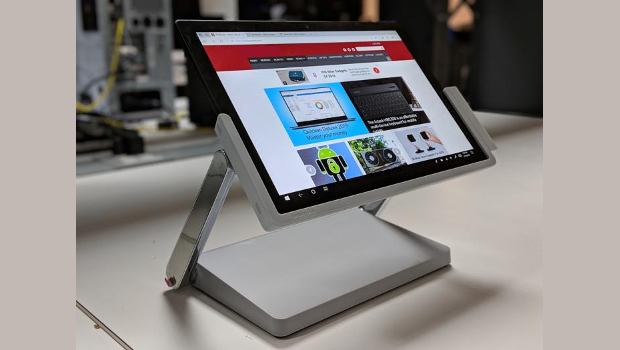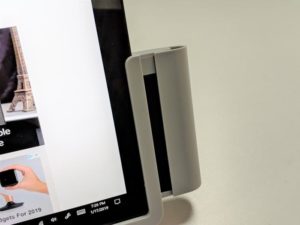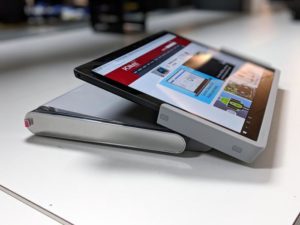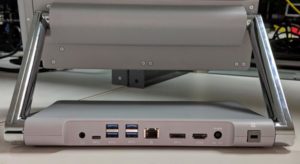
Hands on: Kensington SD7000 dock
For years, Microsoft Surface fans have wondered two things: first, would Microsoft ever sell a standalone version of its massive Surface Studio display? And second, when would the company update its Surface Dock? The Kensington SD7000 Surface Pro Docking Station answers both questions… sort of.
Put simply, Kensington’s SD700 features the “zero-gravity hinge” construction of the Surface Studio, but instead of a massive 25-inch, 4.5K screen, there is a partial frame which can hold a Surface Pro 4, Surface Pro (2017), or Surface Pro 6. We would call the SD7000 a sort-of hybrid between a tablet stand and a dock, which can also serve as an inking surface, should you need that.
‘Grabbed’
In some ways, the SD7000 reminds me of the first generation of Surface Pro docks, which “grabbed” each side of the tablet and featured a port extender at the Surface Connector slot. To use the SD7000, you slide the Surface Pro tablet into the SD7000’s frame, then hold the device in place by snapping a side handle closed. Naturally, you will immediately discover one limitation: you have to remove the Type Cover.

The SD7000 ‘grabs’ the Surface Pro (Image: IDGNS)
Meanwhile, on the rear of the SD7000’s base, there is an array of ports: four USB 3.0 ports, an Ethernet port, a full-sized DisplayPort++ 1.2 port, HDMI, a Kensington lock (naturally), and a headphone jack. Finally, there is also a USB-C port, though it is data only. (USB-C is a feature of the Surface Studio 2, though not the Surface tablets.)
In all, it is a solid idea, executed solidly — until you factor price into the equation. The Kensington SD7000 docking station costs €427.66 here — which sounds a lot, and it is. The one saving grace is that Microsoft already charges €234.95 for the Surface Dock, though prices are lower elsewhere.
Sturdy and useful
Though the Surface Pro is a mobile device, the SD7000 decidedly is not: at nearly 3.3kg, the SD7000 is weighted to hold the Surface Pro firmly. Though the SD7000’s construction is plastic, a large metal hinge and arms smoothly moves the tablet receptacle flat upwards through 65 degrees or so. A secondary hinge also rotates the receptacle itself by about 90 degrees.
Both hinges allow you to adjust the tablet through a wide range of positions. At its highest point, the tablet cannot get quite vertical, though the slight angle is actually more ergonomic. At its lowest point, the tablet reclines to about 30 degrees.

Fully reclined for inking (Image: IDGNS)
Unfortunately, the hinge is not quite strong enough to support the full weight of the tablet if you lower it close to the desktop, so it sags until the tablet’s weight is supported by the flat surface. On the other hand, the SD7000’s construction also allows you to place the dock on a desk, then drop it down to where it’s hanging off the edge, onto a keyboard drawer.
The SD7000’s inability to support the tablet’s weight is annoying if you are planning on using it as a monitor; as an inking surface, the sag is perfectly acceptable. Keep in mind that the built-in kickstand of the Surface line-up allows you to recline the tablet further than the SD7000, though with a bit of unwanted springiness that isn’t present in the SD7000. The frame goes just partway up the Surface tablet, providing plenty of area for the tablet to cool itself under load.
Limitations
As a dock, the SD7000 is hampered by the limitations of the Surface Connector — though the dock can support more than one physical display, only a single 4K display can be run at 60Hz. If two are connected, the display bandwidth must be split into two 4K connections at a sub-standard 30Hz — a limitation of the Surface, however, and not the SD7000.
Unfortunately, Kensington followed Microsoft’s cue with the Surface Studio and placed the SD7000’s ports on the rear. It might be a strong choice aesthetically, but functionally it is not: you will be rotating the entire contraption around to insert any new cable or device. But the SD7000 also receives power through its power cord, which it passes along to the tablet. The sleeve construction also keeps accessible the USB Type A and miniDP ports already on the Surface Pro. If you already own a Surface Pro tablet, chances are you already own a miniDP-to-HDMI cable anyway, making the full-sized DisplayPort and HDMI connectors on the SD7000 somewhat irrelevant.
Kensington’s SD7000 plays into the odd little ecosystem of devices that can control more than one PC at a time, enabled by apps like Microsoft’s own Mouse without Borders app, as well as the Logitech MX Master 2S and its Logitech Flow technology. It is up to you whether you will want to use the Surface Pro tablet as your primary device, or just use the SD7000 to put it in a convenient position as a secondary display.
Either way, convenience is a pricey proposition for the SD7000. But without Microsoft stepping in to provide its own docking alternative, who can blame Kensington for filling the gap?
IDG News Service







Subscribers 0
Fans 0
Followers 0
Followers